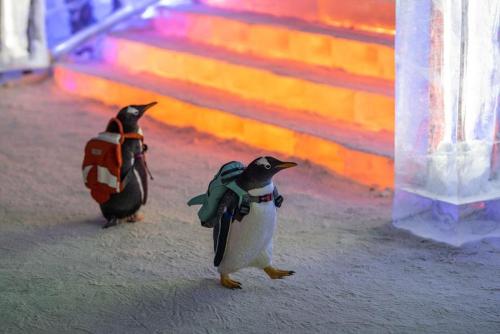Penguins Attend Classes On The First Day Of School At The University Of Antarctica, 2007

Penguins attend classes on the first day of school at the University of Antarctica, 2007
More Posts from Eggxecutive-dysfunction and Others

This little friend was in my dream last night


Okay, but what if there were dinosaurs that did the heron thing?



):

Jupiter s Swimming Storm : A bright storm head with a long turbulent wake swims across Jupiter in these sharp telescopic images of the Solar System’s ruling gas giant. Captured on August 26, 28, and September 1 (left to right) the storm approximately doubles in length during that period. Stretching along the jetstream of the planet’s North Temperate Belt it travels eastward in successive frames, passing the Great Red Spot and whitish Oval BA, famous storms in Jupiter’s southern hemisphere. Galilean moons Callisto and Io are caught in the middle frame. In fact, telescopic skygazers following Jupiter in planet Earth’s night have reported dramatic fast moving storm outbreaks over the past few weeks in Jupiter’s North Temperate Belt. via NASA

Mars, Pleiades, and Andromeda over Stone Lions : Three very different – and very famous – objects were all captured in a single frame last month. On the upper left is the bright blue Pleiades, perhaps the most famous cluster of stars on the night sky. The Pleiades (M45) is about 450 light years away and easily found a few degrees from Orion. On the upper right is the expansive Andromeda Galaxy, perhaps the most famous galaxy – external to our own – on the night sky. Andromeda (M31) is one of few objects visible to the unaided eye where you can see light that is millions of years old. In the middle is bright red Mars, perhaps the most famous planet on the night sky. Today Mars is at opposition, meaning that it is opposite the Sun, with the result that it is visible all night long. In the foreground is an ancient tomb in the Phygrian Valley in Turkey. The tomb, featuring two stone lions, is an impressive remnant of a powerful civilization that lived thousands of years ago. Mars, currently near its brightest, can be easily found toward the east just after sunset. via NASA


European Robin (Erithacus rubecula)
© James Yates Photo
-
 createdbytinypuppets liked this · 3 weeks ago
createdbytinypuppets liked this · 3 weeks ago -
 schroobie liked this · 3 weeks ago
schroobie liked this · 3 weeks ago -
 birdy-boi liked this · 3 weeks ago
birdy-boi liked this · 3 weeks ago -
 officialmyshithole reblogged this · 3 weeks ago
officialmyshithole reblogged this · 3 weeks ago -
 shanklinthestabpossum reblogged this · 3 weeks ago
shanklinthestabpossum reblogged this · 3 weeks ago -
 mega-suicune reblogged this · 3 weeks ago
mega-suicune reblogged this · 3 weeks ago -
 generatedusername reblogged this · 3 weeks ago
generatedusername reblogged this · 3 weeks ago -
 generatedusername liked this · 3 weeks ago
generatedusername liked this · 3 weeks ago -
 notcryptidaddy liked this · 3 weeks ago
notcryptidaddy liked this · 3 weeks ago -
 stshipper reblogged this · 3 weeks ago
stshipper reblogged this · 3 weeks ago -
 fagathaharkness42069 liked this · 3 weeks ago
fagathaharkness42069 liked this · 3 weeks ago -
 gay-rados reblogged this · 3 weeks ago
gay-rados reblogged this · 3 weeks ago -
 spawnartisticdirections liked this · 3 weeks ago
spawnartisticdirections liked this · 3 weeks ago -
 matty-johnson liked this · 3 weeks ago
matty-johnson liked this · 3 weeks ago -
 dairyalternative liked this · 3 weeks ago
dairyalternative liked this · 3 weeks ago -
 gaysbashback reblogged this · 3 weeks ago
gaysbashback reblogged this · 3 weeks ago -
 afanc liked this · 3 weeks ago
afanc liked this · 3 weeks ago -
 twoteaspoons reblogged this · 3 weeks ago
twoteaspoons reblogged this · 3 weeks ago -
 tyronepowerbottom liked this · 3 weeks ago
tyronepowerbottom liked this · 3 weeks ago -
 colourofthekites reblogged this · 3 weeks ago
colourofthekites reblogged this · 3 weeks ago -
 troileandtubble liked this · 3 weeks ago
troileandtubble liked this · 3 weeks ago -
 hyper-tiny-plant-daddy reblogged this · 3 weeks ago
hyper-tiny-plant-daddy reblogged this · 3 weeks ago -
 layneelkins reblogged this · 3 weeks ago
layneelkins reblogged this · 3 weeks ago -
 layneelkins liked this · 3 weeks ago
layneelkins liked this · 3 weeks ago -
 rodiontds liked this · 3 weeks ago
rodiontds liked this · 3 weeks ago -
 artsyh3artsy reblogged this · 1 month ago
artsyh3artsy reblogged this · 1 month ago -
 mylovelornf4ce liked this · 1 month ago
mylovelornf4ce liked this · 1 month ago -
 switchbladefightclub reblogged this · 1 month ago
switchbladefightclub reblogged this · 1 month ago -
 walkingblisters reblogged this · 1 month ago
walkingblisters reblogged this · 1 month ago -
 royalarchive2 reblogged this · 1 month ago
royalarchive2 reblogged this · 1 month ago -
 dmb-lck reblogged this · 1 month ago
dmb-lck reblogged this · 1 month ago -
 isupportorbitalbombardment liked this · 1 month ago
isupportorbitalbombardment liked this · 1 month ago -
 um-pinguim-bolado reblogged this · 1 month ago
um-pinguim-bolado reblogged this · 1 month ago -
 oniricidades reblogged this · 1 month ago
oniricidades reblogged this · 1 month ago -
 paleniezabija21 reblogged this · 1 month ago
paleniezabija21 reblogged this · 1 month ago -
 nastyyygrl reblogged this · 1 month ago
nastyyygrl reblogged this · 1 month ago -
 en-dorstoi liked this · 1 month ago
en-dorstoi liked this · 1 month ago -
 fulcrum-x1 reblogged this · 1 month ago
fulcrum-x1 reblogged this · 1 month ago -
 psico-k reblogged this · 1 month ago
psico-k reblogged this · 1 month ago -
 alexaaaaadsjnfj liked this · 1 month ago
alexaaaaadsjnfj liked this · 1 month ago -
 omegaskiess liked this · 1 month ago
omegaskiess liked this · 1 month ago -
 im-bad-at-this liked this · 1 month ago
im-bad-at-this liked this · 1 month ago -
 drowninspace liked this · 1 month ago
drowninspace liked this · 1 month ago -
 enbyhubby reblogged this · 1 month ago
enbyhubby reblogged this · 1 month ago -
 foxestar liked this · 1 month ago
foxestar liked this · 1 month ago -
 walkingblisters liked this · 1 month ago
walkingblisters liked this · 1 month ago -
 hemoglobin reblogged this · 1 month ago
hemoglobin reblogged this · 1 month ago -
 xde40 liked this · 2 months ago
xde40 liked this · 2 months ago -
 harmlessfroggi liked this · 2 months ago
harmlessfroggi liked this · 2 months ago





